Interpreting Diploma: Health Portfolio - Glossary & Terminology
VerifiedAdded on 2023/06/12
|33
|8857
|162
Portfolio
AI Summary
This assignment is a health portfolio designed for students pursuing a Diploma of Interpreting, specifically focusing on building glossaries for translating and interpreting projects within healthcare settings. The portfolio covers essential aspects of the Australian healthcare system, including its structure, key personnel, and various departments and specialties within hospitals. It delves into basic anatomy and anatomical terms, fundamental word structures, common medical conditions, routine medical procedures, and the use of euphemisms in health interpreting. Furthermore, the portfolio emphasizes the roles and responsibilities of interpreters, security protocols, confidentiality, and privacy considerations. The assignment requires students to define key terms, label diagrams of body systems, and demonstrate an understanding of medical terminology, contributing to a shared online glossary to enhance their practical interpreting skills in health-related contexts. The student is also expected to research and translate medical terms in context.
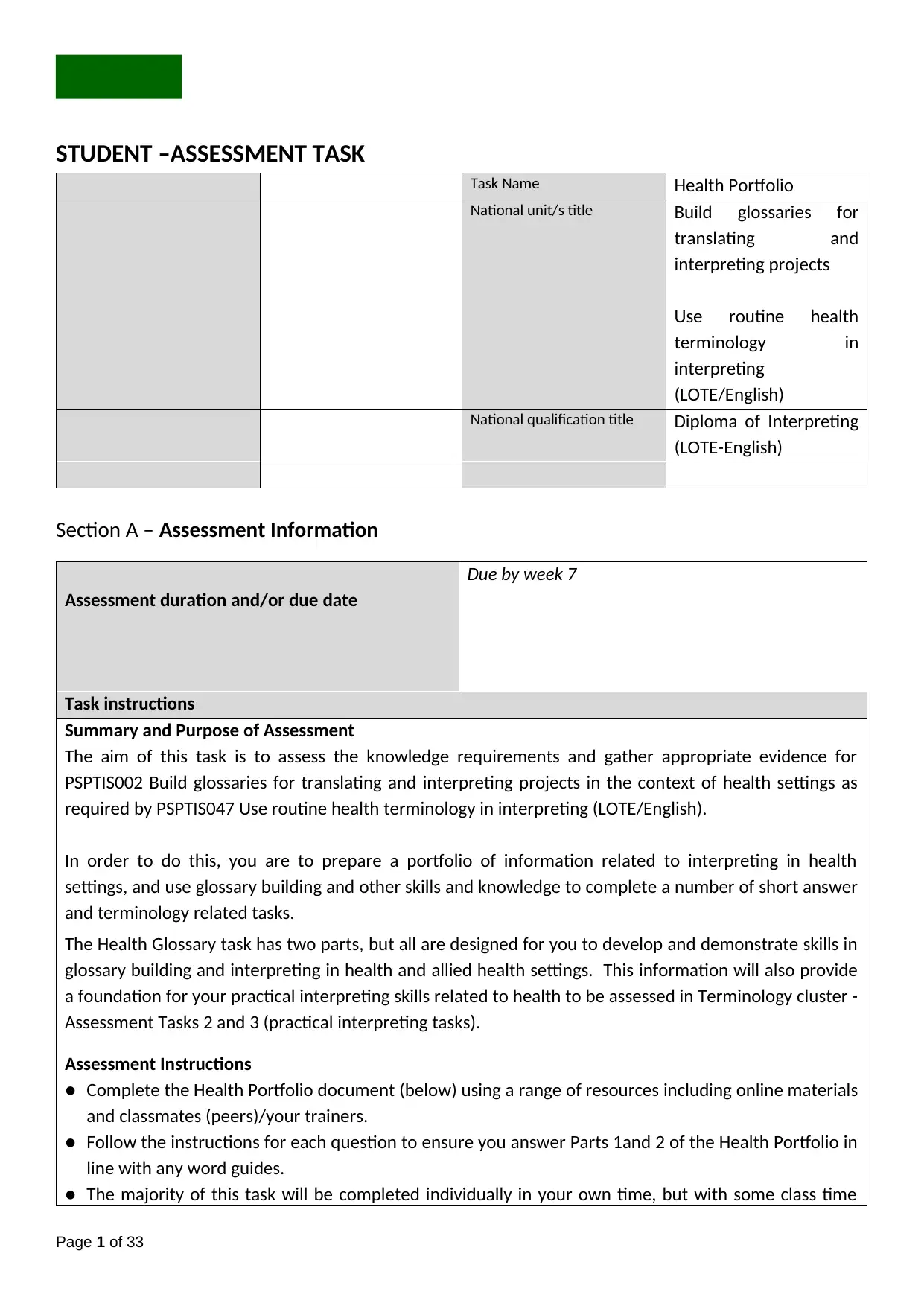
STUDENT –ASSESSMENT TASK
Task Name Health Portfolio
National unit/s title Build glossaries for
translating and
interpreting projects
Use routine health
terminology in
interpreting
(LOTE/English)
National qualification title Diploma of Interpreting
(LOTE-English)
Section A – Assessment Information
Assessment duration and/or due date
Due by week 7
Task instructions
Summary and Purpose of Assessment
The aim of this task is to assess the knowledge requirements and gather appropriate evidence for
PSPTIS002 Build glossaries for translating and interpreting projects in the context of health settings as
required by PSPTIS047 Use routine health terminology in interpreting (LOTE/English).
In order to do this, you are to prepare a portfolio of information related to interpreting in health
settings, and use glossary building and other skills and knowledge to complete a number of short answer
and terminology related tasks.
The Health Glossary task has two parts, but all are designed for you to develop and demonstrate skills in
glossary building and interpreting in health and allied health settings. This information will also provide
a foundation for your practical interpreting skills related to health to be assessed in Terminology cluster -
Assessment Tasks 2 and 3 (practical interpreting tasks).
Assessment Instructions
● Complete the Health Portfolio document (below) using a range of resources including online materials
and classmates (peers)/your trainers.
● Follow the instructions for each question to ensure you answer Parts 1and 2 of the Health Portfolio in
line with any word guides.
● The majority of this task will be completed individually in your own time, but with some class time
Page 1 of 33
Task Name Health Portfolio
National unit/s title Build glossaries for
translating and
interpreting projects
Use routine health
terminology in
interpreting
(LOTE/English)
National qualification title Diploma of Interpreting
(LOTE-English)
Section A – Assessment Information
Assessment duration and/or due date
Due by week 7
Task instructions
Summary and Purpose of Assessment
The aim of this task is to assess the knowledge requirements and gather appropriate evidence for
PSPTIS002 Build glossaries for translating and interpreting projects in the context of health settings as
required by PSPTIS047 Use routine health terminology in interpreting (LOTE/English).
In order to do this, you are to prepare a portfolio of information related to interpreting in health
settings, and use glossary building and other skills and knowledge to complete a number of short answer
and terminology related tasks.
The Health Glossary task has two parts, but all are designed for you to develop and demonstrate skills in
glossary building and interpreting in health and allied health settings. This information will also provide
a foundation for your practical interpreting skills related to health to be assessed in Terminology cluster -
Assessment Tasks 2 and 3 (practical interpreting tasks).
Assessment Instructions
● Complete the Health Portfolio document (below) using a range of resources including online materials
and classmates (peers)/your trainers.
● Follow the instructions for each question to ensure you answer Parts 1and 2 of the Health Portfolio in
line with any word guides.
● The majority of this task will be completed individually in your own time, but with some class time
Page 1 of 33
Paraphrase This Document
Need a fresh take? Get an instant paraphrase of this document with our AI Paraphraser
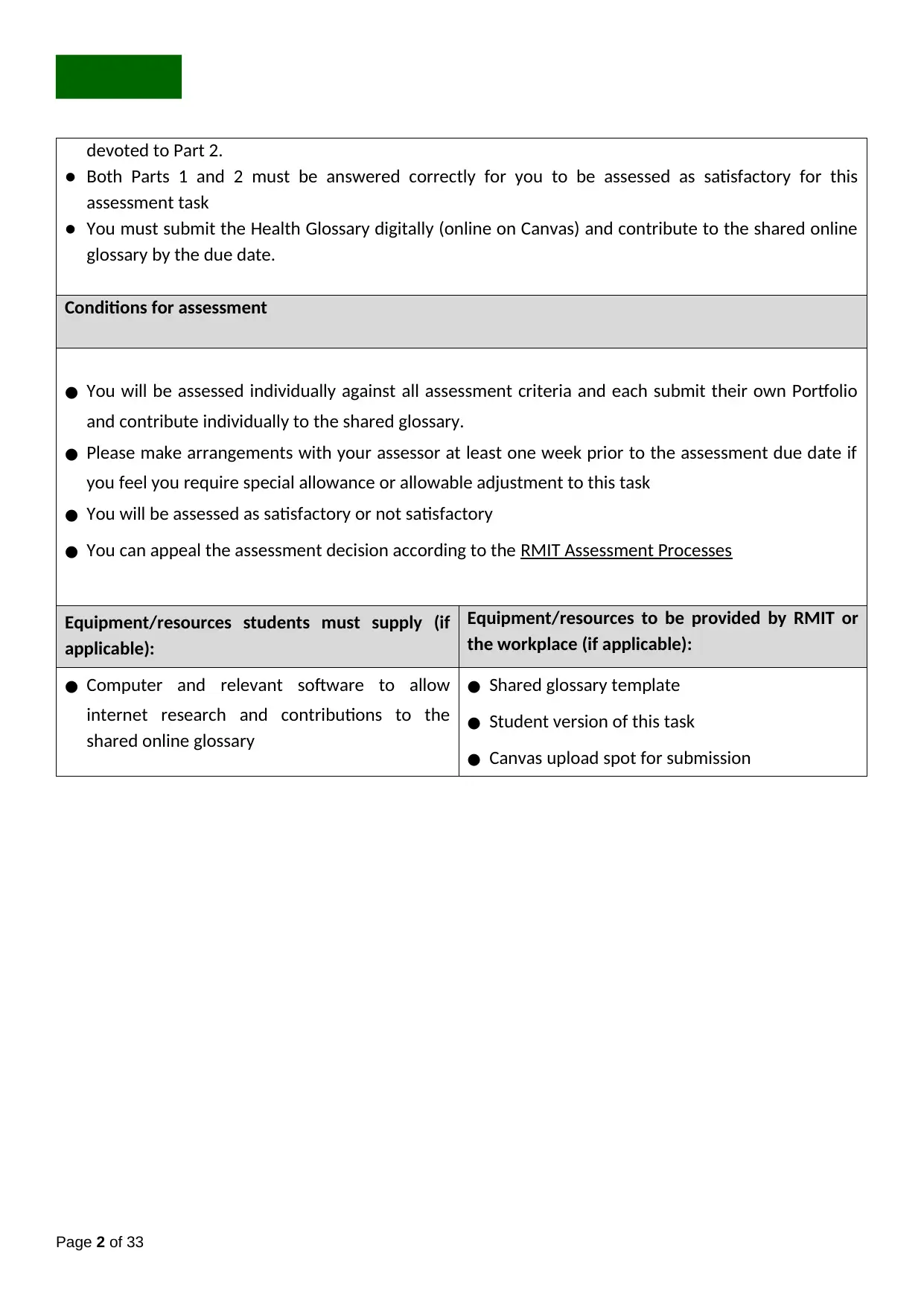
devoted to Part 2.
● Both Parts 1 and 2 must be answered correctly for you to be assessed as satisfactory for this
assessment task
● You must submit the Health Glossary digitally (online on Canvas) and contribute to the shared online
glossary by the due date.
Conditions for assessment
● You will be assessed individually against all assessment criteria and each submit their own Portfolio
and contribute individually to the shared glossary.
● Please make arrangements with your assessor at least one week prior to the assessment due date if
you feel you require special allowance or allowable adjustment to this task
● You will be assessed as satisfactory or not satisfactory
● You can appeal the assessment decision according to the RMIT Assessment Processes
Equipment/resources students must supply (if
applicable):
Equipment/resources to be provided by RMIT or
the workplace (if applicable):
● Computer and relevant software to allow
internet research and contributions to the
shared online glossary
● Shared glossary template
● Student version of this task
● Canvas upload spot for submission
Page 2 of 33
● Both Parts 1 and 2 must be answered correctly for you to be assessed as satisfactory for this
assessment task
● You must submit the Health Glossary digitally (online on Canvas) and contribute to the shared online
glossary by the due date.
Conditions for assessment
● You will be assessed individually against all assessment criteria and each submit their own Portfolio
and contribute individually to the shared glossary.
● Please make arrangements with your assessor at least one week prior to the assessment due date if
you feel you require special allowance or allowable adjustment to this task
● You will be assessed as satisfactory or not satisfactory
● You can appeal the assessment decision according to the RMIT Assessment Processes
Equipment/resources students must supply (if
applicable):
Equipment/resources to be provided by RMIT or
the workplace (if applicable):
● Computer and relevant software to allow
internet research and contributions to the
shared online glossary
● Shared glossary template
● Student version of this task
● Canvas upload spot for submission
Page 2 of 33
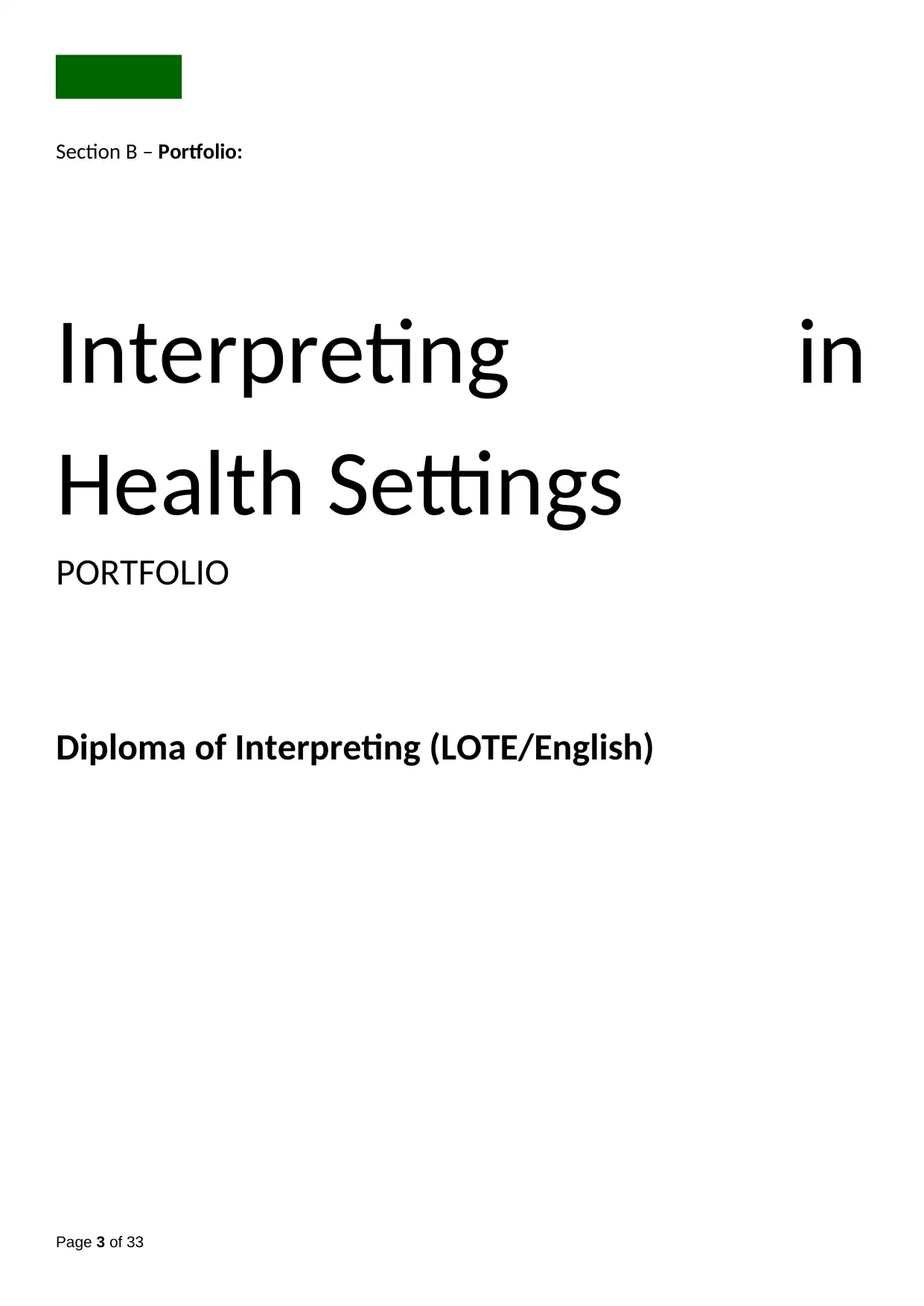
Section B – Portfolio:
Interpreting in
Health Settings
PORTFOLIO
Diploma of Interpreting (LOTE/English)
Page 3 of 33
Interpreting in
Health Settings
PORTFOLIO
Diploma of Interpreting (LOTE/English)
Page 3 of 33
⊘ This is a preview!⊘
Do you want full access?
Subscribe today to unlock all pages.

Trusted by 1+ million students worldwide
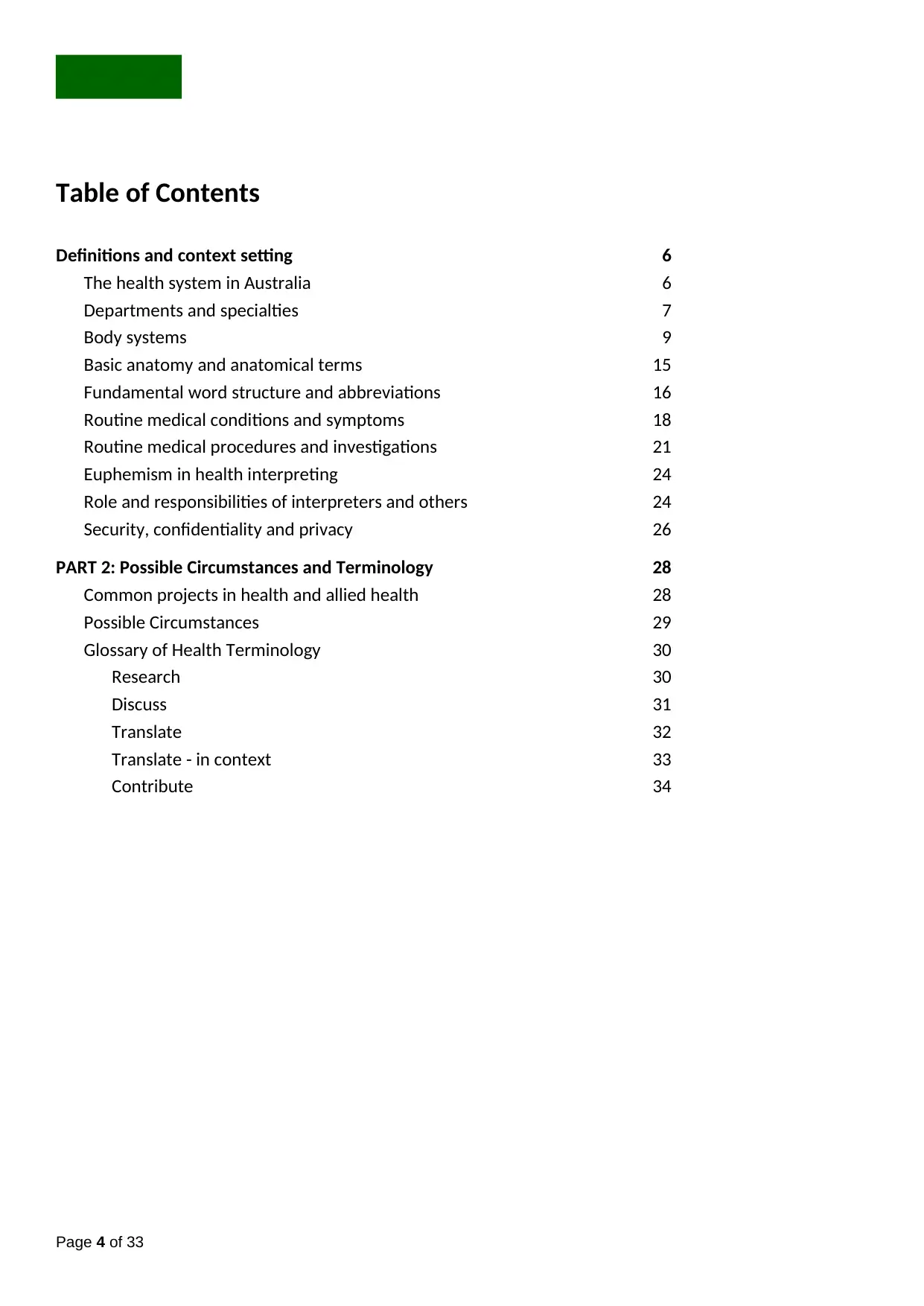
Table of Contents
Definitions and context setting 6
The health system in Australia 6
Departments and specialties 7
Body systems 9
Basic anatomy and anatomical terms 15
Fundamental word structure and abbreviations 16
Routine medical conditions and symptoms 18
Routine medical procedures and investigations 21
Euphemism in health interpreting 24
Role and responsibilities of interpreters and others 24
Security, confidentiality and privacy 26
PART 2: Possible Circumstances and Terminology 28
Common projects in health and allied health 28
Possible Circumstances 29
Glossary of Health Terminology 30
Research 30
Discuss 31
Translate 32
Translate - in context 33
Contribute 34
Page 4 of 33
Definitions and context setting 6
The health system in Australia 6
Departments and specialties 7
Body systems 9
Basic anatomy and anatomical terms 15
Fundamental word structure and abbreviations 16
Routine medical conditions and symptoms 18
Routine medical procedures and investigations 21
Euphemism in health interpreting 24
Role and responsibilities of interpreters and others 24
Security, confidentiality and privacy 26
PART 2: Possible Circumstances and Terminology 28
Common projects in health and allied health 28
Possible Circumstances 29
Glossary of Health Terminology 30
Research 30
Discuss 31
Translate 32
Translate - in context 33
Contribute 34
Page 4 of 33
Paraphrase This Document
Need a fresh take? Get an instant paraphrase of this document with our AI Paraphraser
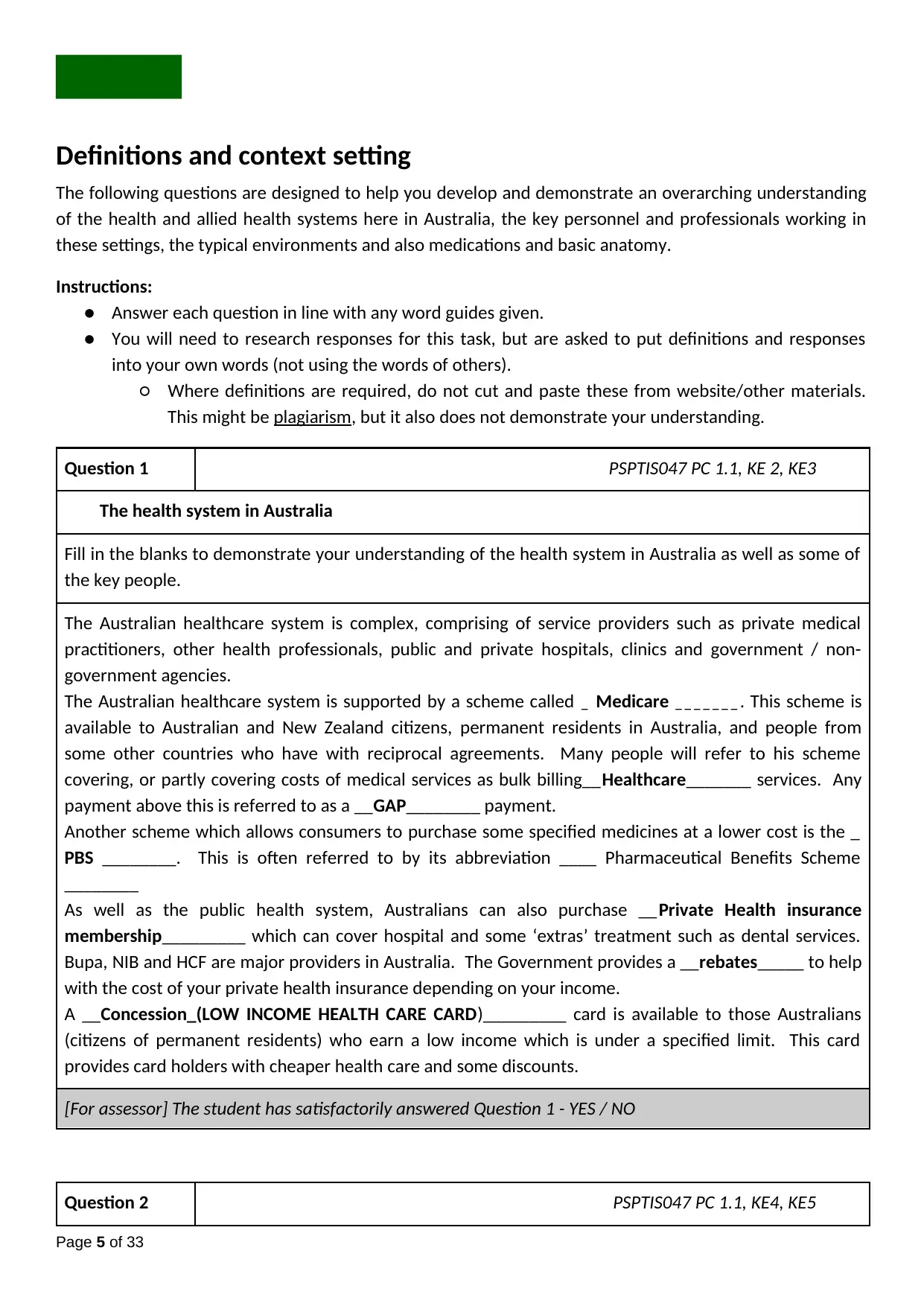
Definitions and context setting
The following questions are designed to help you develop and demonstrate an overarching understanding
of the health and allied health systems here in Australia, the key personnel and professionals working in
these settings, the typical environments and also medications and basic anatomy.
Instructions:
● Answer each question in line with any word guides given.
● You will need to research responses for this task, but are asked to put definitions and responses
into your own words (not using the words of others).
○ Where definitions are required, do not cut and paste these from website/other materials.
This might be plagiarism, but it also does not demonstrate your understanding.
Question 1 PSPTIS047 PC 1.1, KE 2, KE3
The health system in Australia
Fill in the blanks to demonstrate your understanding of the health system in Australia as well as some of
the key people.
The Australian healthcare system is complex, comprising of service providers such as private medical
practitioners, other health professionals, public and private hospitals, clinics and government / non-
government agencies.
The Australian healthcare system is supported by a scheme called _ Medicare _______. This scheme is
available to Australian and New Zealand citizens, permanent residents in Australia, and people from
some other countries who have with reciprocal agreements. Many people will refer to his scheme
covering, or partly covering costs of medical services as bulk billing__Healthcare_______ services. Any
payment above this is referred to as a __GAP________ payment.
Another scheme which allows consumers to purchase some specified medicines at a lower cost is the _
PBS ________. This is often referred to by its abbreviation ____ Pharmaceutical Benefits Scheme
________
As well as the public health system, Australians can also purchase __Private Health insurance
membership_________ which can cover hospital and some ‘extras’ treatment such as dental services.
Bupa, NIB and HCF are major providers in Australia. The Government provides a __rebates_____ to help
with the cost of your private health insurance depending on your income.
A __Concession_(LOW INCOME HEALTH CARE CARD)_________ card is available to those Australians
(citizens of permanent residents) who earn a low income which is under a specified limit. This card
provides card holders with cheaper health care and some discounts.
[For assessor] The student has satisfactorily answered Question 1 - YES / NO
Question 2 PSPTIS047 PC 1.1, KE4, KE5
Page 5 of 33
The following questions are designed to help you develop and demonstrate an overarching understanding
of the health and allied health systems here in Australia, the key personnel and professionals working in
these settings, the typical environments and also medications and basic anatomy.
Instructions:
● Answer each question in line with any word guides given.
● You will need to research responses for this task, but are asked to put definitions and responses
into your own words (not using the words of others).
○ Where definitions are required, do not cut and paste these from website/other materials.
This might be plagiarism, but it also does not demonstrate your understanding.
Question 1 PSPTIS047 PC 1.1, KE 2, KE3
The health system in Australia
Fill in the blanks to demonstrate your understanding of the health system in Australia as well as some of
the key people.
The Australian healthcare system is complex, comprising of service providers such as private medical
practitioners, other health professionals, public and private hospitals, clinics and government / non-
government agencies.
The Australian healthcare system is supported by a scheme called _ Medicare _______. This scheme is
available to Australian and New Zealand citizens, permanent residents in Australia, and people from
some other countries who have with reciprocal agreements. Many people will refer to his scheme
covering, or partly covering costs of medical services as bulk billing__Healthcare_______ services. Any
payment above this is referred to as a __GAP________ payment.
Another scheme which allows consumers to purchase some specified medicines at a lower cost is the _
PBS ________. This is often referred to by its abbreviation ____ Pharmaceutical Benefits Scheme
________
As well as the public health system, Australians can also purchase __Private Health insurance
membership_________ which can cover hospital and some ‘extras’ treatment such as dental services.
Bupa, NIB and HCF are major providers in Australia. The Government provides a __rebates_____ to help
with the cost of your private health insurance depending on your income.
A __Concession_(LOW INCOME HEALTH CARE CARD)_________ card is available to those Australians
(citizens of permanent residents) who earn a low income which is under a specified limit. This card
provides card holders with cheaper health care and some discounts.
[For assessor] The student has satisfactorily answered Question 1 - YES / NO
Question 2 PSPTIS047 PC 1.1, KE4, KE5
Page 5 of 33
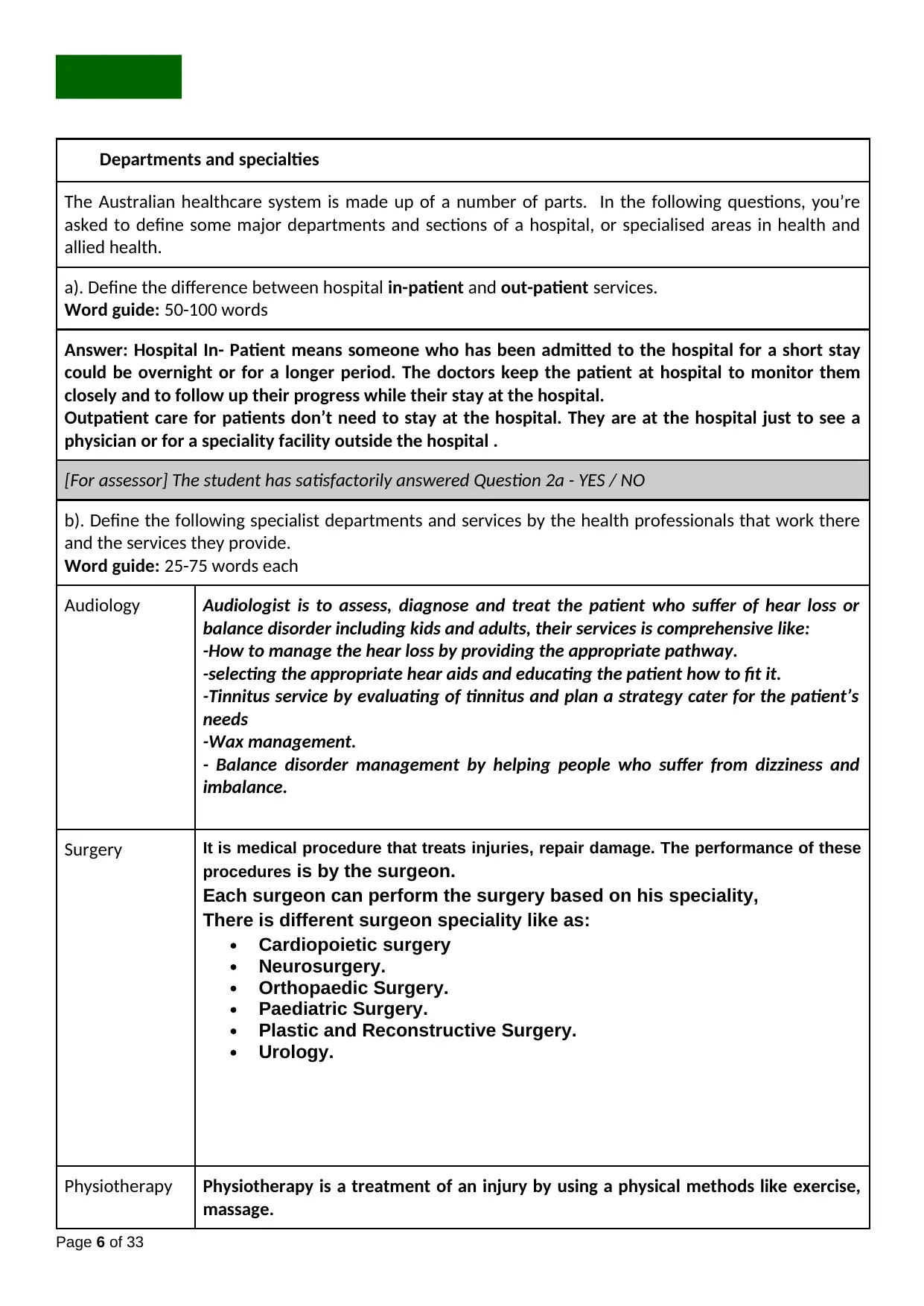
Departments and specialties
The Australian healthcare system is made up of a number of parts. In the following questions, you’re
asked to define some major departments and sections of a hospital, or specialised areas in health and
allied health.
a). Define the difference between hospital in-patient and out-patient services.
Word guide: 50-100 words
Answer: Hospital In- Patient means someone who has been admitted to the hospital for a short stay
could be overnight or for a longer period. The doctors keep the patient at hospital to monitor them
closely and to follow up their progress while their stay at the hospital.
Outpatient care for patients don’t need to stay at the hospital. They are at the hospital just to see a
physician or for a speciality facility outside the hospital .
[For assessor] The student has satisfactorily answered Question 2a - YES / NO
b). Define the following specialist departments and services by the health professionals that work there
and the services they provide.
Word guide: 25-75 words each
Audiology Audiologist is to assess, diagnose and treat the patient who suffer of hear loss or
balance disorder including kids and adults, their services is comprehensive like:
-How to manage the hear loss by providing the appropriate pathway.
-selecting the appropriate hear aids and educating the patient how to fit it.
-Tinnitus service by evaluating of tinnitus and plan a strategy cater for the patient’s
needs
-Wax management.
- Balance disorder management by helping people who suffer from dizziness and
imbalance.
Surgery It is medical procedure that treats injuries, repair damage. The performance of these
procedures is by the surgeon.
Each surgeon can perform the surgery based on his speciality,
There is different surgeon speciality like as:
Cardiopoietic surgery
Neurosurgery.
Orthopaedic Surgery.
Paediatric Surgery.
Plastic and Reconstructive Surgery.
Urology.
Physiotherapy Physiotherapy is a treatment of an injury by using a physical methods like exercise,
massage.
Page 6 of 33
The Australian healthcare system is made up of a number of parts. In the following questions, you’re
asked to define some major departments and sections of a hospital, or specialised areas in health and
allied health.
a). Define the difference between hospital in-patient and out-patient services.
Word guide: 50-100 words
Answer: Hospital In- Patient means someone who has been admitted to the hospital for a short stay
could be overnight or for a longer period. The doctors keep the patient at hospital to monitor them
closely and to follow up their progress while their stay at the hospital.
Outpatient care for patients don’t need to stay at the hospital. They are at the hospital just to see a
physician or for a speciality facility outside the hospital .
[For assessor] The student has satisfactorily answered Question 2a - YES / NO
b). Define the following specialist departments and services by the health professionals that work there
and the services they provide.
Word guide: 25-75 words each
Audiology Audiologist is to assess, diagnose and treat the patient who suffer of hear loss or
balance disorder including kids and adults, their services is comprehensive like:
-How to manage the hear loss by providing the appropriate pathway.
-selecting the appropriate hear aids and educating the patient how to fit it.
-Tinnitus service by evaluating of tinnitus and plan a strategy cater for the patient’s
needs
-Wax management.
- Balance disorder management by helping people who suffer from dizziness and
imbalance.
Surgery It is medical procedure that treats injuries, repair damage. The performance of these
procedures is by the surgeon.
Each surgeon can perform the surgery based on his speciality,
There is different surgeon speciality like as:
Cardiopoietic surgery
Neurosurgery.
Orthopaedic Surgery.
Paediatric Surgery.
Plastic and Reconstructive Surgery.
Urology.
Physiotherapy Physiotherapy is a treatment of an injury by using a physical methods like exercise,
massage.
Page 6 of 33
⊘ This is a preview!⊘
Do you want full access?
Subscribe today to unlock all pages.

Trusted by 1+ million students worldwide
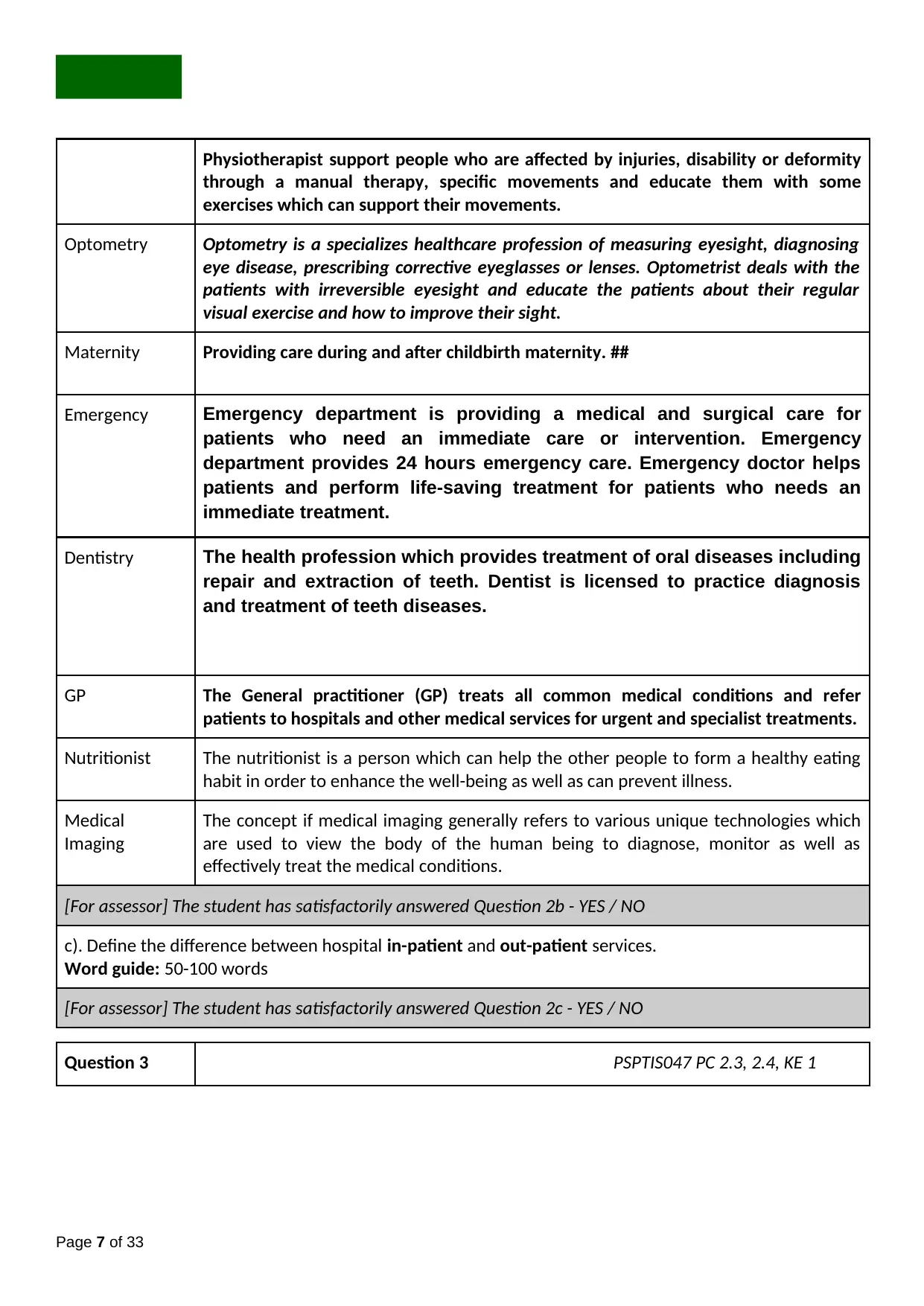
Physiotherapist support people who are affected by injuries, disability or deformity
through a manual therapy, specific movements and educate them with some
exercises which can support their movements.
Optometry Optometry is a specializes healthcare profession of measuring eyesight, diagnosing
eye disease, prescribing corrective eyeglasses or lenses. Optometrist deals with the
patients with irreversible eyesight and educate the patients about their regular
visual exercise and how to improve their sight.
Maternity Providing care during and after childbirth maternity. ##
Emergency Emergency department is providing a medical and surgical care for
patients who need an immediate care or intervention. Emergency
department provides 24 hours emergency care. Emergency doctor helps
patients and perform life-saving treatment for patients who needs an
immediate treatment.
Dentistry The health profession which provides treatment of oral diseases including
repair and extraction of teeth. Dentist is licensed to practice diagnosis
and treatment of teeth diseases.
GP The General practitioner (GP) treats all common medical conditions and refer
patients to hospitals and other medical services for urgent and specialist treatments.
Nutritionist The nutritionist is a person which can help the other people to form a healthy eating
habit in order to enhance the well-being as well as can prevent illness.
Medical
Imaging
The concept if medical imaging generally refers to various unique technologies which
are used to view the body of the human being to diagnose, monitor as well as
effectively treat the medical conditions.
[For assessor] The student has satisfactorily answered Question 2b - YES / NO
c). Define the difference between hospital in-patient and out-patient services.
Word guide: 50-100 words
[For assessor] The student has satisfactorily answered Question 2c - YES / NO
Question 3 PSPTIS047 PC 2.3, 2.4, KE 1
Page 7 of 33
through a manual therapy, specific movements and educate them with some
exercises which can support their movements.
Optometry Optometry is a specializes healthcare profession of measuring eyesight, diagnosing
eye disease, prescribing corrective eyeglasses or lenses. Optometrist deals with the
patients with irreversible eyesight and educate the patients about their regular
visual exercise and how to improve their sight.
Maternity Providing care during and after childbirth maternity. ##
Emergency Emergency department is providing a medical and surgical care for
patients who need an immediate care or intervention. Emergency
department provides 24 hours emergency care. Emergency doctor helps
patients and perform life-saving treatment for patients who needs an
immediate treatment.
Dentistry The health profession which provides treatment of oral diseases including
repair and extraction of teeth. Dentist is licensed to practice diagnosis
and treatment of teeth diseases.
GP The General practitioner (GP) treats all common medical conditions and refer
patients to hospitals and other medical services for urgent and specialist treatments.
Nutritionist The nutritionist is a person which can help the other people to form a healthy eating
habit in order to enhance the well-being as well as can prevent illness.
Medical
Imaging
The concept if medical imaging generally refers to various unique technologies which
are used to view the body of the human being to diagnose, monitor as well as
effectively treat the medical conditions.
[For assessor] The student has satisfactorily answered Question 2b - YES / NO
c). Define the difference between hospital in-patient and out-patient services.
Word guide: 50-100 words
[For assessor] The student has satisfactorily answered Question 2c - YES / NO
Question 3 PSPTIS047 PC 2.3, 2.4, KE 1
Page 7 of 33
Paraphrase This Document
Need a fresh take? Get an instant paraphrase of this document with our AI Paraphraser
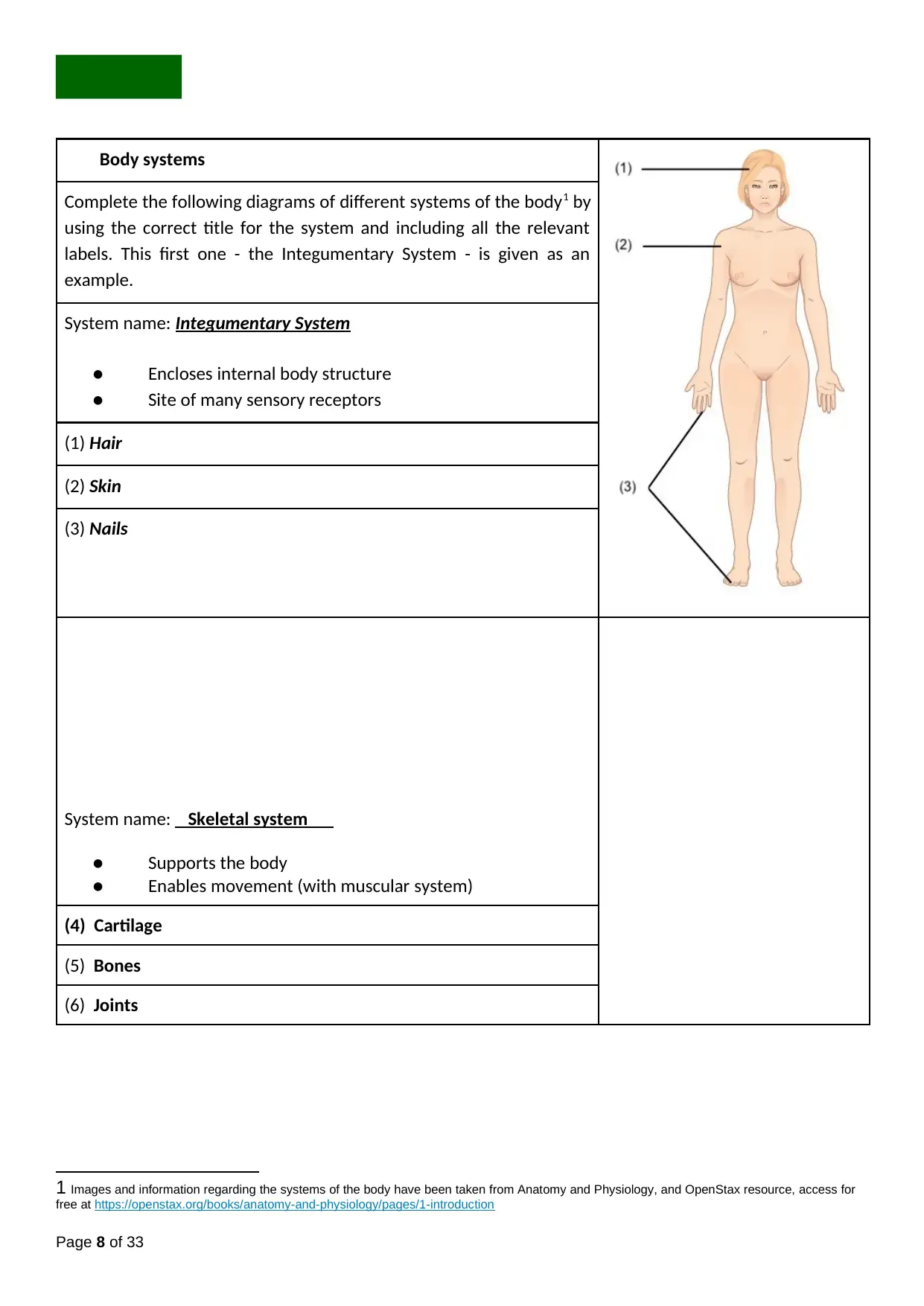
Body systems
Complete the following diagrams of different systems of the body1 by
using the correct title for the system and including all the relevant
labels. This first one - the Integumentary System - is given as an
example.
System name: Integumentary System
● Encloses internal body structure
● Site of many sensory receptors
(1) Hair
(2) Skin
(3) Nails
System name: Skeletal system
● Supports the body
● Enables movement (with muscular system)
(4) Cartilage
(5) Bones
(6) Joints
1 Images and information regarding the systems of the body have been taken from Anatomy and Physiology, and OpenStax resource, access for
free at https://openstax.org/books/anatomy-and-physiology/pages/1-introduction
Page 8 of 33
Complete the following diagrams of different systems of the body1 by
using the correct title for the system and including all the relevant
labels. This first one - the Integumentary System - is given as an
example.
System name: Integumentary System
● Encloses internal body structure
● Site of many sensory receptors
(1) Hair
(2) Skin
(3) Nails
System name: Skeletal system
● Supports the body
● Enables movement (with muscular system)
(4) Cartilage
(5) Bones
(6) Joints
1 Images and information regarding the systems of the body have been taken from Anatomy and Physiology, and OpenStax resource, access for
free at https://openstax.org/books/anatomy-and-physiology/pages/1-introduction
Page 8 of 33
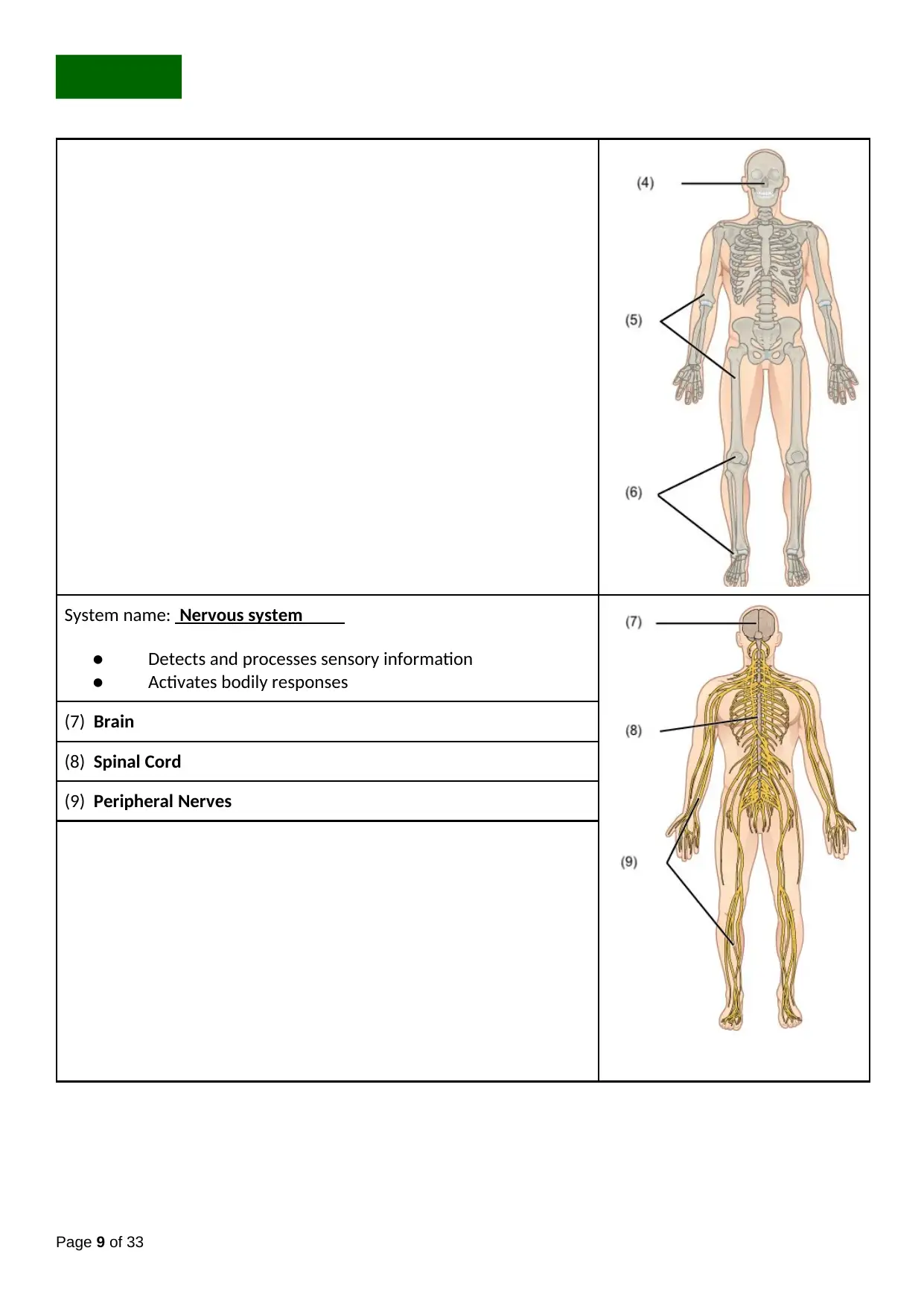
System name: Nervous system
● Detects and processes sensory information
● Activates bodily responses
(7) Brain
(8) Spinal Cord
(9) Peripheral Nerves
Page 9 of 33
● Detects and processes sensory information
● Activates bodily responses
(7) Brain
(8) Spinal Cord
(9) Peripheral Nerves
Page 9 of 33
⊘ This is a preview!⊘
Do you want full access?
Subscribe today to unlock all pages.

Trusted by 1+ million students worldwide
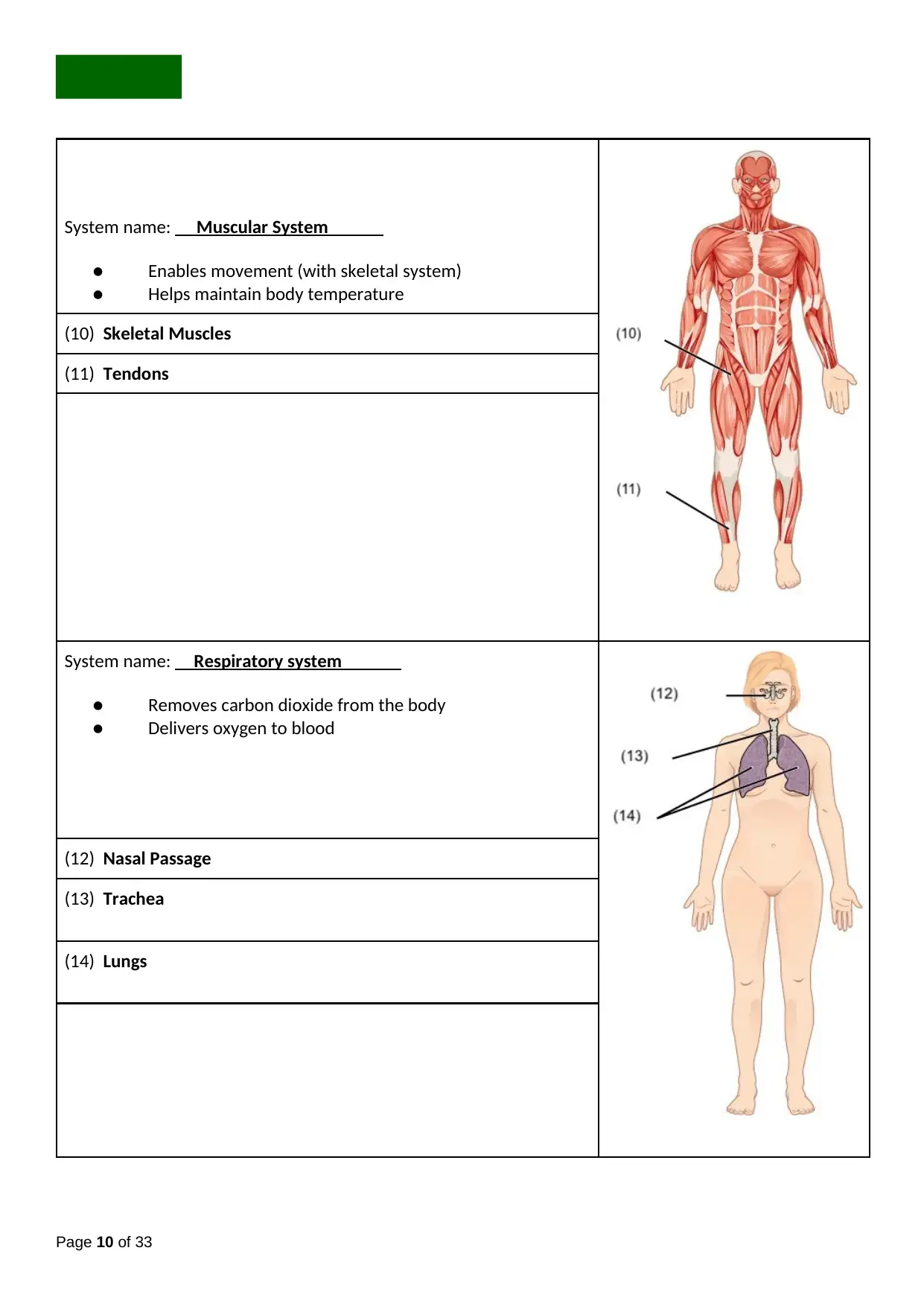
System name: Muscular System
● Enables movement (with skeletal system)
● Helps maintain body temperature
(10) Skeletal Muscles
(11) Tendons
System name: __Respiratory system
● Removes carbon dioxide from the body
● Delivers oxygen to blood
(12) Nasal Passage
(13) Trachea
(14) Lungs
Page 10 of 33
● Enables movement (with skeletal system)
● Helps maintain body temperature
(10) Skeletal Muscles
(11) Tendons
System name: __Respiratory system
● Removes carbon dioxide from the body
● Delivers oxygen to blood
(12) Nasal Passage
(13) Trachea
(14) Lungs
Page 10 of 33
Paraphrase This Document
Need a fresh take? Get an instant paraphrase of this document with our AI Paraphraser
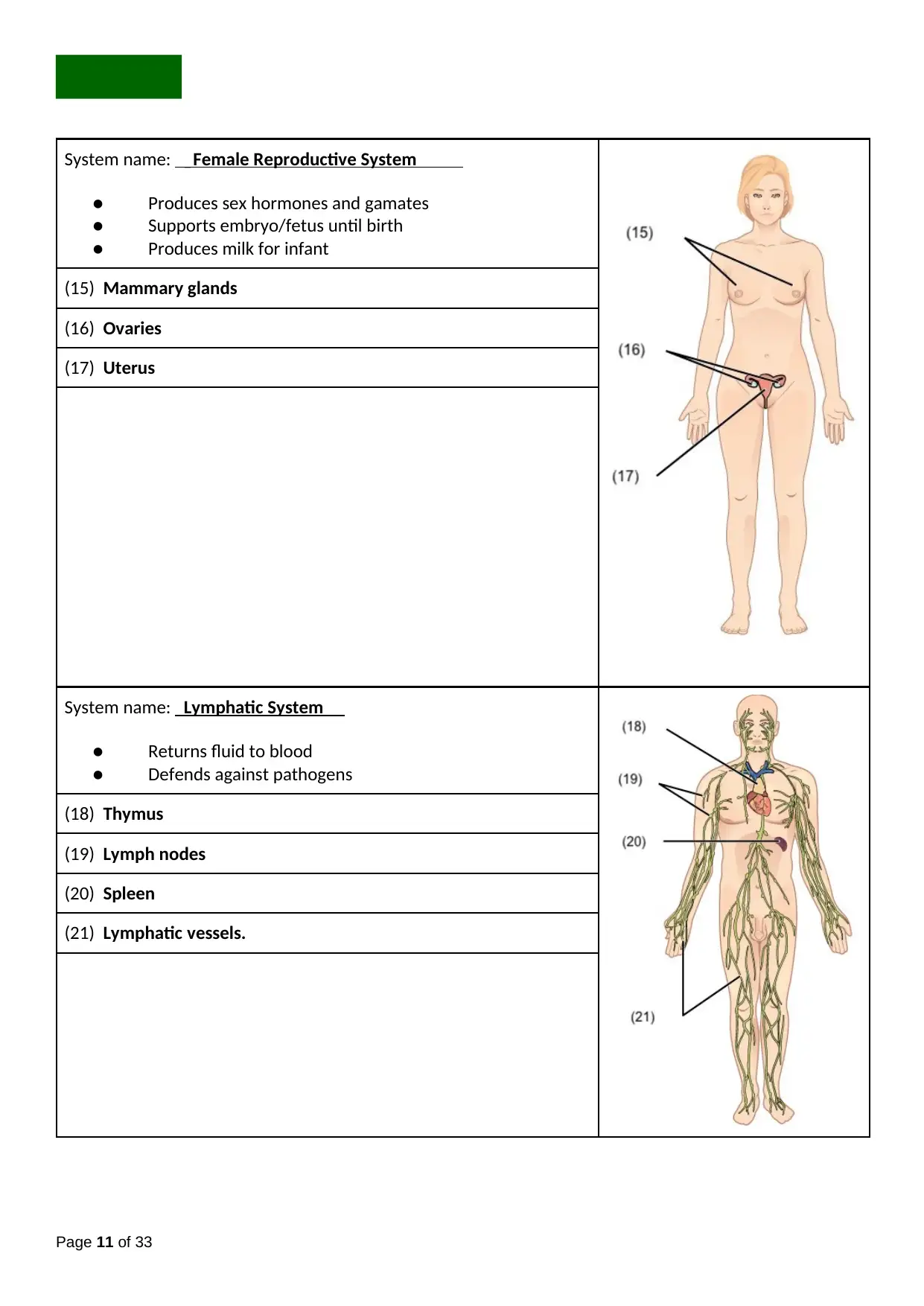
System name: _Female Reproductive System
● Produces sex hormones and gamates
● Supports embryo/fetus until birth
● Produces milk for infant
(15) Mammary glands
(16) Ovaries
(17) Uterus
System name: Lymphatic System
● Returns fluid to blood
● Defends against pathogens
(18) Thymus
(19) Lymph nodes
(20) Spleen
(21) Lymphatic vessels.
Page 11 of 33
● Produces sex hormones and gamates
● Supports embryo/fetus until birth
● Produces milk for infant
(15) Mammary glands
(16) Ovaries
(17) Uterus
System name: Lymphatic System
● Returns fluid to blood
● Defends against pathogens
(18) Thymus
(19) Lymph nodes
(20) Spleen
(21) Lymphatic vessels.
Page 11 of 33
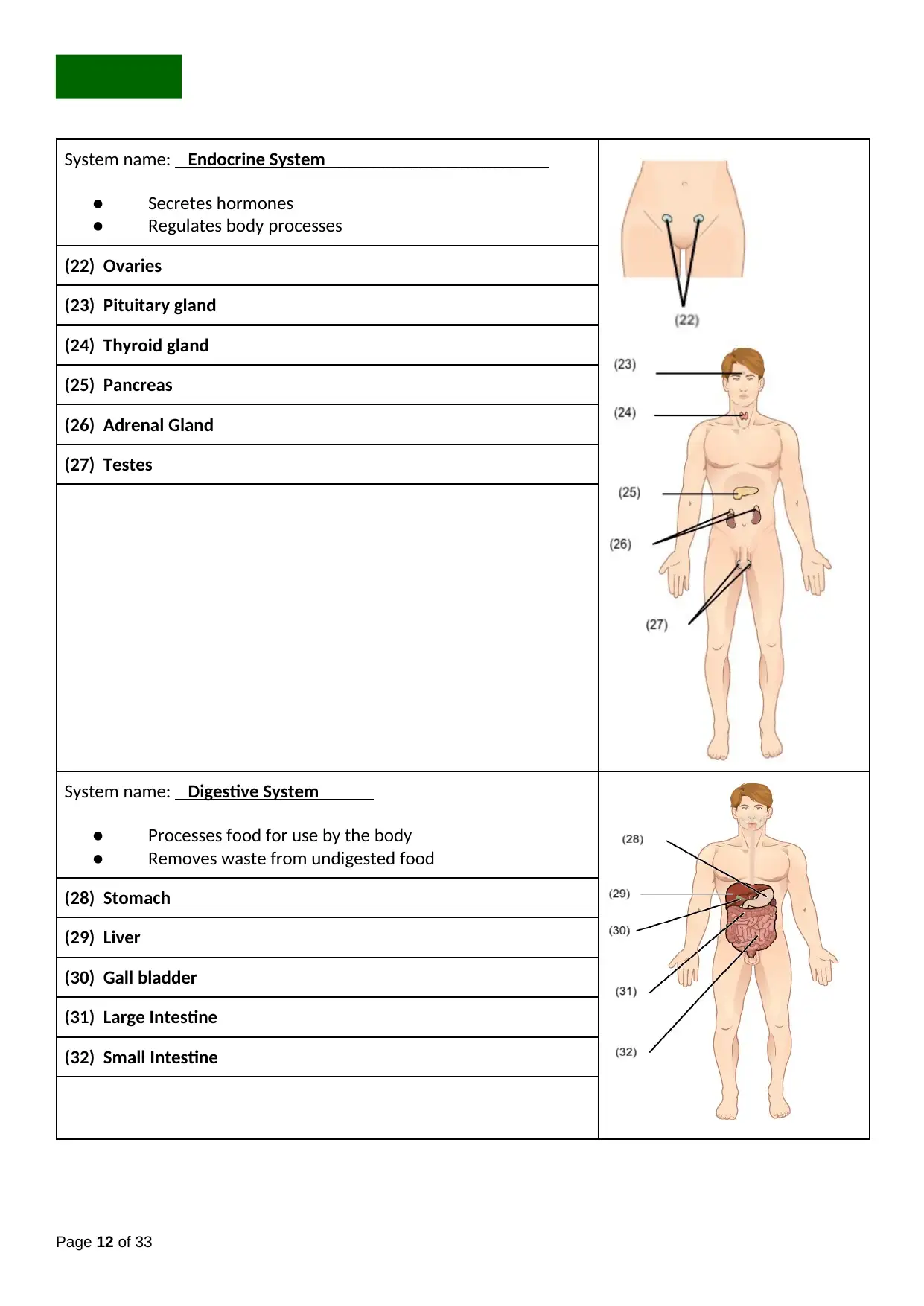
System name: Endocrine System ____________________
● Secretes hormones
● Regulates body processes
(22) Ovaries
(23) Pituitary gland
(24) Thyroid gland
(25) Pancreas
(26) Adrenal Gland
(27) Testes
System name: Digestive System
● Processes food for use by the body
● Removes waste from undigested food
(28) Stomach
(29) Liver
(30) Gall bladder
(31) Large Intestine
(32) Small Intestine
Page 12 of 33
● Secretes hormones
● Regulates body processes
(22) Ovaries
(23) Pituitary gland
(24) Thyroid gland
(25) Pancreas
(26) Adrenal Gland
(27) Testes
System name: Digestive System
● Processes food for use by the body
● Removes waste from undigested food
(28) Stomach
(29) Liver
(30) Gall bladder
(31) Large Intestine
(32) Small Intestine
Page 12 of 33
⊘ This is a preview!⊘
Do you want full access?
Subscribe today to unlock all pages.

Trusted by 1+ million students worldwide
1 out of 33
Related Documents
Your All-in-One AI-Powered Toolkit for Academic Success.
+13062052269
info@desklib.com
Available 24*7 on WhatsApp / Email
![[object Object]](/_next/static/media/star-bottom.7253800d.svg)
Unlock your academic potential
Copyright © 2020–2025 A2Z Services. All Rights Reserved. Developed and managed by ZUCOL.





